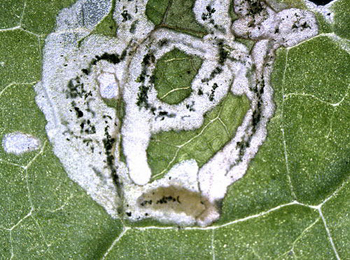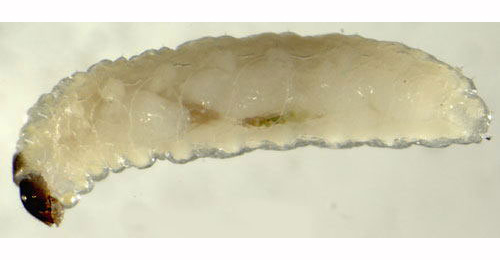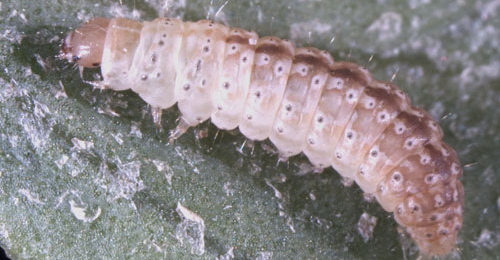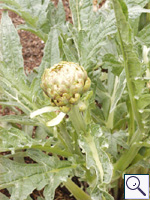|
||||||
|
CAKILE. Sea Rocket. [Brassicaceae] |
|
|
Only one species of Cakile, Sea Rocket (C. maritima), is recorded in Britain. It is native. The BSBI provide a downloadable plant crib for Brassicaceae. Five British miners are recorded on Cakile. A key to the European miners recorded on Cakile is provided in Bladmineerders van Europa. |
|
|
Key for the identification of the known mines of British |
1a > Leaf-miner: Rather small, untidy, full depth, often branched corridor, often close to the leaf margin. Sides irregularly eaten out. Frass in a greyish-green central line that is interrupted from time to time, sometimes partly in strings. In times of rain the frass may run out and appear greenish. Usually several mines in a leaf. The body is whitish; head greyish brown with Y-shaped lighter marking. Pronotum with a pair of brownish shields. The mandibles have two teeth. |
 Mine of Ceutorhynchus minutus on Raphanus sativus Image: © Willem Ellis (Bladmineerders van Europa) |
 Ceutorhynchus minutus larva, lateral Image: © Willem Ellis (Bladmineerders van Europa) |
|
Ceutorhynchus minutus (Marsham, 1802) [Coleoptera: Curculionidae]. |
1b > Leaf-miner: In the first instar the larva mines the leaves, forming short, irregular, blotch-like mines, but in later instars it lives externally, feeding in spun leaves and often twisting those of tender shoots. Larval head light-brown or yellowish brown, edged with black postero-laterally, ocellar area blackish; prothoracic plate black edged with whitish anteriorly; abdomen dull dark green; pinacula distinct, black, sometimes brownish but with black bases to setae; anal plate large, black (Bradley et al., 1973). Small, full depth mine without a definite shape; little frass. Some silk is deposited in the mine. The larva soon leaves the mine and continues feeding among spun leaves. |
|
Cnephasia incertana (Treitschke, 1835) [Lepidoptera: Tortricidae]. |
1c > Leaf-miner: The first instar larva tends to make a U-shaped mine, whereas later larvae make irregular mines. Final instar larvae spin the leaves together and feed in a silken tube amongst the seeds. Young larvae make a short, spiralled corridor typically U-shaped). This stage is followed by an irregular, sometimes branching, greenish-white blotch. In their final stage the larva lives free in a silken tunnel among the leaves. Pupation in a cocoon of sand grains and detritus. |
 Scrobipalpa nitentella larva, dorsal Image: © Willem Ellis (Bladmineerders van Europa) |
|
Scrobipalpa nitentella (Fuchs, 1902) [Lepidoptera: Gelechiidae]. |
1d > Leaf-miner: Corridor-blotch mine, normally dorsal; usually whitish; in small leaves it lies characteristically in the centre of the leaf often touching the petiole; in larger leaves it lies to one side of the mid-rib. Frass deposited in green clumps near the leaf margin. Pupation usually external, sometimes in a separate pupation mine. Oviposition whitin the leaf, at the lower surface. The first part of the mine is a long, sometimes very long, corridor, that mostly will be overrun by the later developments. Generally this corridor is directed, frequently guided by a thick vein, to the midrib. The next section of the mine is large, irregular blotch overlying the basal section of the midrib. Locally large chunks of midrib tissue are consumed. From this central blotch excursions are made into the leaf blade: generally upper-surface, less often lower-surface and locally full-depth. In plants with narrow leaves, like Diplotaxis, the mine may occupy the entire width of the leaf. Often several larvae together in a mine. Frass blackish green, powdery, in clouds, sometimes along the sides of the corridors, later more in the periphery of the mine and in the end of extensions of the blotch, sometimes seemingly absent. (Often the frass can only be seen after the mine has been opened). Pupation generally in the ground, rarely within he leaf, in a short mine without frass. Hendel (1928a) described the biology, larva and puparium. An initial narrow gallery then leads to a blotch on the midrib of the leaf. Watch a video of a scaptomyzid fly larva on Arabidopsis on YouTube by mash92587. |
|
Scaptomyza flava (Fallén, 1823) [Diptera: Drosophilidae]. |
1b> Leaf-miner: Mine linear, whitish, both upper and lower surface. Pupation internal, at the end of the mine with the anterior spiracles projecting through the epidermis (Spencer, 1976: 433). Upper-surface, less often lower-surface corridor. Frass in isolated grains. Pupation within the mine, usually in a lower-surface puparial chamber. A long whitish upper surface corridor, which eventually goes lower surface. |
|
Chromatomyia horticola (Goureau, 1851) [Diptera: Agromyzidae]. |
| Last updated 01-Jul-2019 Brian Pitkin | ||

